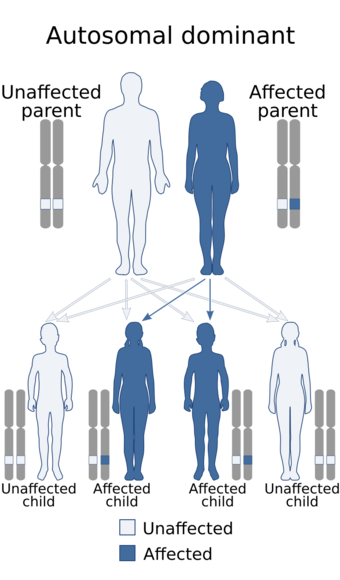Medicine:Spinal muscular atrophy with lower extremity predominance
From HandWiki
Short description: Rare neuromuscular disorder of infants characterised by severe progressive muscle atrophy
| Spinal muscular atrophy with lower extremity predominance | |
|---|---|
| Other names | SMA-LED |
 | |
| Spinal muscular atrophy with lower extremity predominance is inherited in an autosomal dominant manner. | |
| Specialty | Neurology |
Spinal muscular atrophy with lower extremity predominance is an extremely rare neuromuscular disorder of infants characterised by severe progressive muscle atrophy which is especially prominent in legs.[1]
The disorder is associated with a genetic mutation in the DYNC1H1 gene (the gene responsible also for one of the axonal types of Charcot–Marie–Tooth disease)[2][3] and is inherited in an autosomal dominant manner. As with many genetic disorders, there is no known cure to SMA-LED.
The condition was first described in a multi-generational family by Walter Timme in 1917.[4] Its linkage to the DYNC1H1 gene was discovered in 2010 by M. B. Harms, et al., who also proposed the current name of the disorder.[1][5]
See also
References
- ↑ 1.0 1.1 Online Mendelian Inheritance in Man (OMIM) 158600
- ↑ "Mutations in the tail domain of DYNC1H1 cause dominant spinal muscular atrophy". Neurology 78 (16): 1714–20. 2012. doi:10.1212/WNL.0b013e3182556c05. PMID 22459677.
- ↑ Tsurusaki, Y.; Saitoh, S.; Tomizawa, K.; Sudo, A.; Asahina, N.; Shiraishi, H.; Ito, J. I.; Tanaka, H. et al. (2012). "A DYNC1H1 mutation causes a dominant spinal muscular atrophy with lower extremity predominance". Neurogenetics 13 (4): 327–332. doi:10.1007/s10048-012-0337-6. PMID 22847149.
- ↑ Timme, W. (1917). "Progressive Muscular Dystrophy As an Endocrine Disease". Archives of Internal Medicine: 79–104. doi:10.1001/archinte.1917.00080200084004.
- ↑ Harms, M. B.; Allred, P.; Gardner, R.; Fernandes Filho, J. A.; Florence, J.; Pestronk, A.; Al-Lozi, M.; Baloh, R. H. (2010). "Dominant spinal muscular atrophy with lower extremity predominance: Linkage to 14q32". Neurology 75 (6): 539–546. doi:10.1212/WNL.0b013e3181ec800c. PMID 20697106.
| Classification |
|---|
